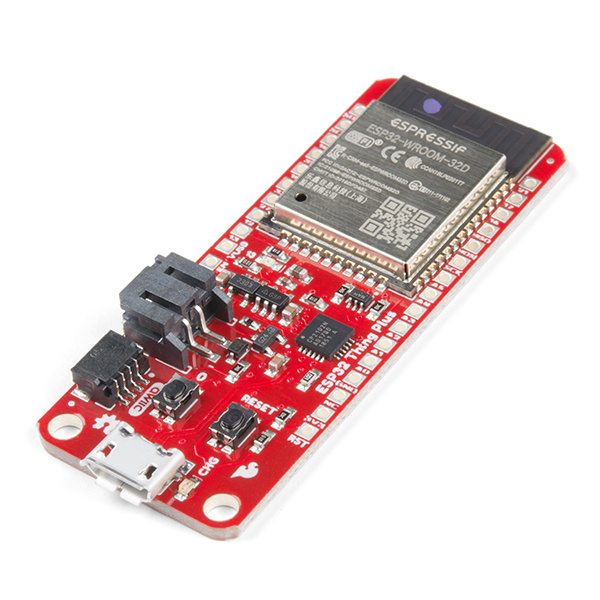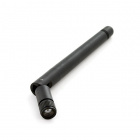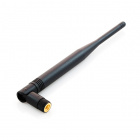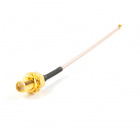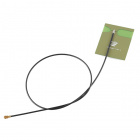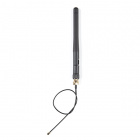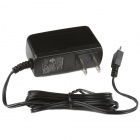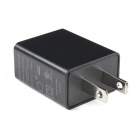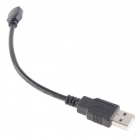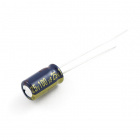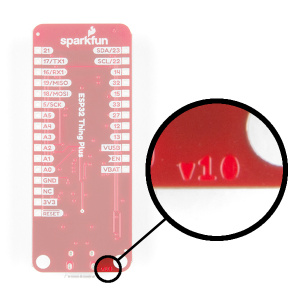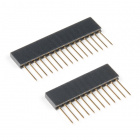Contributors:
Ell C,
 jimblom
jimblom,
 Alex the Giant
Alex the Giant Introduction
The SparkFun ESP32 Thing Plus and the SparkFun ESP32 Thing Plus U.FL enjoy all the amenities of the ESP32 Thing, but with a few added sparkles. We've lengthened the board just a bit to accommodate a Qwiic connector for all your Qwiic breakout needs. We've also moved a few pins around to make the board compatible with the Adafruit Huzzah32 – ESP32 Feather Board such that you can use all of those lovely shields available out there! The ESP32 Thing plus also integrates a rich set of peripherals, ranging from capacitive touch sensors, SD card interface, Ethernet, high-speed SPI, UART, I2S and I2C.
WRL-15663
The SparkFun ESP32 Thing Plus is the next step to get started with Espressif IoT ideations while still enjoying all the ameni…
WRL-17381
The SparkFun ESP32 Thing Plus with U.FL allows you to get started with Espressif IoT ideations while still enjoying all the a…
With Espressif's ESP32 comprehensive development platform, Bluetooth low-energy support (i.e BLE, BT4.0, Bluetooth Smart), and nearly 30 I/O pins, these boards are jam packed with possibilities!
Not Yet Implemented: The Arduino core for the ESP32 microcontroller are still a work in progress. There are a handful of peripherals and features that have yet to be implemented, including:
- Analog Ouptut (
analogWrite([pin], [value]))
- Pulse Counter
- SDIO
Timer/Real-Time Clock
- TWAI
The peripherals are available (if, also, still in their infancy) in the IoT Development Framework for the ESP32. If your application requires any of the features above, consider giving the ESP-IDF a try! (Updated: June 2022.)
Required Materials
Note: For the ESP32 Thing Plus
U.FL, external antenna hardware is required. We offer various
antennas options.
-
Tested with the ESP32 Thing Plus U.FL:
WRL-00145
2.4GHz Duck Antenna 2.2dBi with Reverse Polarized - SMA RF connector. Perfect for prototyping with our RF ICs. 50 ohm impedan…
WRL-00558
2.4GHz Large Duck Antenna 5dBi with Reverse Polarized - SMA RF connector. Perfect for prototyping with our RF ICs. 50 ohm imp…
WRL-00662
Commonly used to attach WiFi, Bluetooth, or nRFxxx based devices to a 2.4GHz antenna.
WRL-11320
This adhesive, omni-directional antenna is perfect for situations when you're trying to get a signal out from a transmitter t…
Retired
-
Untested:
WRL-17389
This is the Antenna Kit for the Raspberry Pi 4 Compute Module wireless variants.
WLAN TRIPLE BAND ANTENNA - 150mm
WRL-17095
TE Connectivity's Wi-Fi 6E Antennas can support triple bands, including the 6GHz band.
Retired
DUAL BAND WLAN / BLUETOOTH ANTENNA - PCB V 200mm
WRL-17341
TE Connectivity's Small Form-Factor WLAN Antennas offers a 2400MHz to 7125MHz frequency range, 50Ω impedance rating, and up …
Retired
Much of the ESP32 Thing Plus's functionality can be used by simply powering the board. To do so, you'll need a Micro-B USB Cable. The ESP32 Thing Plus's USB interface can be used to both power and program the chip. Once you're done programming the chip, a 5V Micro-B USB Wall Adapter can be used to power the board.
TOL-15311
This is a high quality switching 'wall wart' AC to DC 5V 2000mA USB Micro-B wall power supply manufactured specifically for S…
TOL-11456
USB is being implemented as a power connection standard more and more these days, but you don't always have a computer on han…
CAB-13244
This is a USB 2.0 type A to Micro-B 5-pin black cable. You know, the mini-B connector that usually comes with cell phones, Ca…
COM-00096
Electrolytic decoupling capacitors 100uF/25V. These capacitors are great transient/surge suppressors. Attach one between the …
⚡WARNING! If you have v1.0 of the board [
WRL-14689], make sure your power supply is
5V, NOT 5.1V. We have noticed a power spike in our
5.1V power supplies that can damage the IC. Long cables can also generate a large enough voltage spike to damage the IC. We recommend keeping power supply cables shorter than 6 feet to minimize potential damage.
To avoid voltage spikes that might damage the IC, we recommend soldering a 10Ω resistor in-line. If you have v2.0 of the board [
WRL-15663] , this issue has been addressed and you can disregard this message.
As an alternative power source, the ESP32 Thing Plus includes support for single-cell lithium-polymer (LiPo) batteries, which plug into the board's white 2-pin JST connector. LiPos are perfect for projects on-the-go, or those that just need a little extra umph. The board includes a LiPo charger -- the rechargeable batteries can be juiced back up by plugging the Thing Plus into a 5V USB source.
PRT-13854
These are very slim, extremely light weight batteries based on Lithium Ion chemistry. Each cell outputs a nominal 3.7V at 850…
PRT-13851
This is a very small, extremely lightweight battery based on Lithium Ion chemistry, with the highest energy density currently…
PRT-13855
These are very slim, extremely light weight batteries based on Lithium Ion chemistry. Each cell outputs a nominal 3.7V at 200…
PRT-13813
Slim, extremely light weight batteries based on Lithium Ion chemistry. Each cell outputs a nominal 3.7V at 1000 mAh!
Retired
Should you wish to make use of the board's qwiic functionality, you'll need a qwiic cable:
PRT-14427
This is a 100mm long 4-conductor cable with 1mm JST termination. It’s designed to connect Qwiic enabled components together…
Retired
PRT-14426
This is a 50mm long 4-conductor cable with 1mm JST termination. It’s designed to connect Qwiic enabled components together …
Retired
PRT-14428
This is a 200mm long 4-conductor cable with 1mm JST termination. It’s designed to connect Qwiic enabled components together…
Retired
PRT-14429
This is a 500mm long 4-conductor cable with 1mm JST termination. It’s designed to connect Qwiic enabled components together…
Retired
Tools
To take advantage of the ESP32 Thing Plus's 28 external pins, you will need a soldering iron, solder, and general soldering accessories.
PRT-00116
A row of headers - break to fit. 40 pins that can be cut to any size. Used with custom PCBs or general custom headers.
TOL-09325
This is your basic spool of lead free solder with a water soluble resin core. 0.031" gauge and 100 grams. This is a good spoo…
PRT-15187
These stackable headers are made to work with the [SparkFun ESP32 Thing Plus](https://www.sparkfun.com/products/14689) to con…
TOL-14228
The WLC100 from Weller is a versatile 5 watt to 40 watt soldering station that is perfect for hobbyists, DIYers and students.…
Retired
Suggested Reading
It may look intimidating, but the ESP32 Thing Plus -- especially when you take advantage of its Arduino compatibility -- is a perfect IoT foundation for electronics users of all experience levels. There are, however, a few concepts you should be familiar with before venturing further into this tutorial. If any of the concepts below sound foreign to you, consider reading through that tutorial first:
Serial Communication
Asynchronous serial communication concepts: packets, signal levels, baud rates, UARTs and more!
What is an Arduino?
What is this 'Arduino' thing anyway? This tutorials dives into what an Arduino is and along with Arduino projects and widgets.
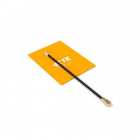 Retired
Retired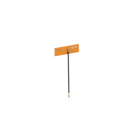 Retired
Retired